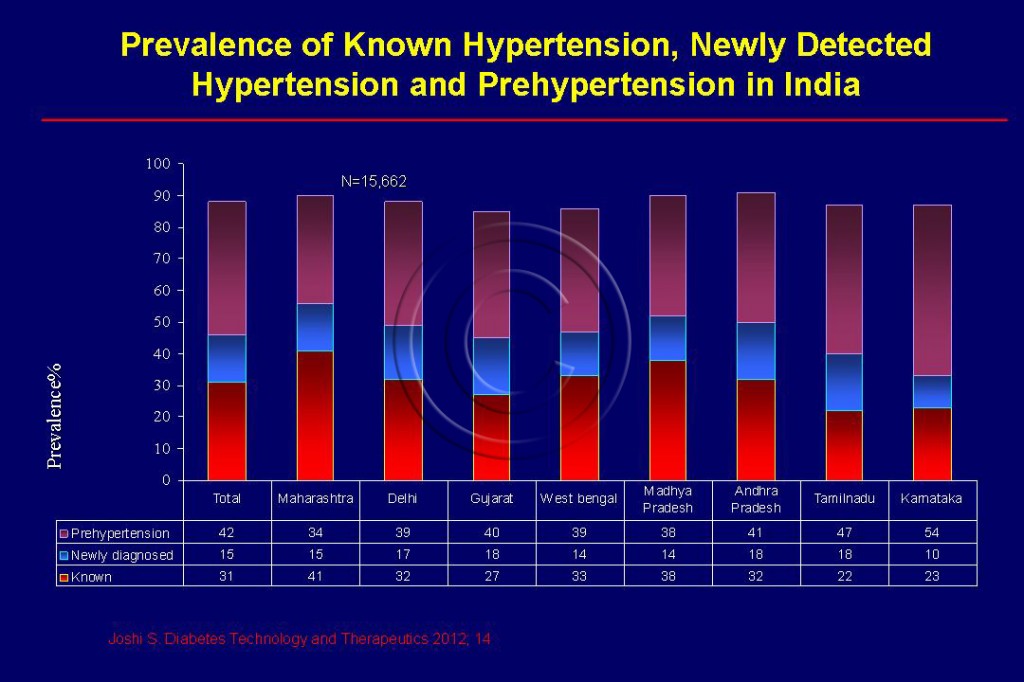Prehypertension
- Prehypertension is defined as a systolic blood pressure reading between 120 and 139 and a diastolic blood pressure of 80 to 89. Systolic blood pressure is the upper number in a blood pressure measurement and refers to the pressure when the heart beats while pumping blood. Diastolic blood pressure, the lower number, is the pressure when the heart is at rest between beats. A blood pressure reading of less than 120/80 is considered ideal.
- The category of prehypertension, was introduced to emphasize that persons whose blood pressure is >120/80 mm Hg are likely to progress to definite hypertension. It was also hoped that doctors will encourage persons with pre-hypertension to begin lifestyle modifications to prevent its progression to hypertension.
- One in three healthy adults in the US has prehypertension, and it often occurs with prediabetes, which is found in one in four adults. One in ten has both of these conditions and often occurs in combination with obesity, high triglycerides, and low HDL (“good” cholesterol) in a condition called metabolic syndrome.2
- In one study, the overall prevalence of prehypertension was very high (about 80%) among young physically active military service men ( mean age 34) and was accompanied by high prevalence of other components of metabolic syndrome such as overweight high triglycerides, low HDL and even LDL cholesterol.6 This indicates an urgent need for targeted interventions to reduce the cardiovascular risk.See Figure 107.
- The prevalence of prehypertension increases with age and is higher in people with diabetes, microalbuminuria, chronic kidney disease, and those with heavy alcohol consumption compared to those without these factors.3
- Prehypertension and hypertension are both a cause and a consequence of chronic kidney disease. Earlier identification and treatment of both these conditions may prevent or delay morbidity and mortality from chronic kidney disease.4
- The recommendations are that persons with pre-hypertension be treated and evaluated about every month or two, until the blood pressure goal is reached and then every 3-6 months thereafter. Persons with complications/end organ damage such as heart or kidney disease may need to be evaluated more frequently at regular intervals.
- Prehypertension responds well to lifestyle changes. Losing about 7% of body weight and engaging in 150 minutes of moderate exercise a week and cutting down on sodium intake can often normalize the blood pressure and avoid progression to hypertension. See salt, sodium and blood pressure.
FAQ
1. What are the implications of high blood pressure in young adultdhood?
A. The researchers of the Harvard Alumni Health Study of 19000 students and followed for 50-75 years found that high blood pressure in early adulthood was associated with significantly increased risk for death from heart disease, cardiovascular disease and all-cause death decades later.
2. Should prehypertension be treated with medications?
A. All people with prehypertension deserve lifestyle modifications especially reduction in intake of salt and alcohol. Those with overt or silent heart disease may also need medications. CAC score may be used in guiding the need for medications in prehypertensives since those with CAC score of >400 has an eight fold risk of CVD events.5
Sources
1. Chobanian AV, Bakris GL, Black HR, et al. The Seventh Report of the Joint National Committee on Prevention, Detection, Evaluation, and Treatment of High Blood Pressure: the JNC 7 report. Jama. 2003;289(19):2560-2572.
2. CardioSmart. American College of Cardiology.
3. Glasser SP, Judd S, Basile J, et al. Prehypertension, Racial Prevalence and Its Association With Risk Factors: Analysis of the REasons for Geographic And Racial Differences in Stroke (REGARDS) Study. Am J Hypertens. Sep 23 2010.
4. Crews DC, Plantinga LC, Miller ER, 3rd, et al. Prevalence of chronic kidney disease in persons with undiagnosed or prehypertension in the United States. Hypertension. May 2010;55(5):1102-1109.
5. Erbel R, Lehmann N, Mohlenkamp S, et al. Subclinical Coronary Atherosclerosis Predicts Cardiovascular Risk in Different Stages of Hypertension: Result of the Heinz Nixdorf Recall Study. Hypertension. Jan 2012;59(1):44-53.
6. Ray S, Kulkarni B, Sreenivas A. Prevalence of prehypertension in young military adults & its association with overweight & dyslipidaemia. Indian J Med Res. Aug 2011;134(2):162-167.


